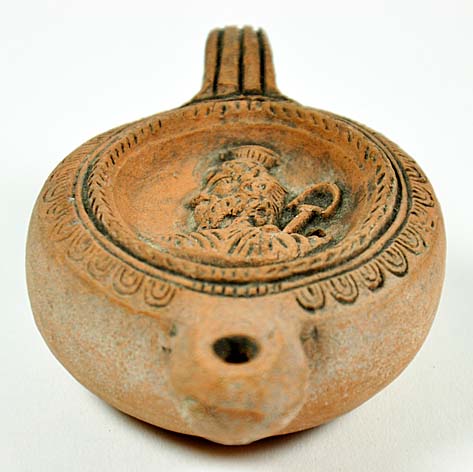As part of my project on the ancient Cypriot collection belonging to North Lanarkshire Council Museums, I’ll be visiting Summerlee Museum later in September to see the objects in person, and start exploring the archives. I can’t wait! In the meantime, I’ve been able to make a start on some initial research based on photographs of some of the objects, including a rather intriguing lamp.
It’s a Roman oil lamp made of terracotta, with a ring handle and moulded decoration including a decorative border on the shoulder and around the discus which contains the central image. This shows a bearded figure in left profile, robed and with a headdress, with a staff appearing behind his left shoulder. There is a filling-hole just below, neatly placed so as not to detract from the image.
Due to the ubiquitous need for lighting, lamps from the ancient Mediterranean survive in large numbers, and are a great source of evidence for ancient lives. Not all of them are decorated by any means, but those which are provide rich evidence of customs, beliefs, and aesthetic preferences. Fortunately there are many scholarly studies of ancient lamps, which make it possible to put individual, unprovenanced examples such as this one into some kind of context.
Thanks to these, the lamp can be dated to the late 2nd – early 3rd century A.D., and the individual depicted can be identified as Serapis, a deity whose cult was promoted by the Ptolemaic dynasty in Egypt from the 3rd century B.C. and who was worshipped widely throughout the Roman empire. He is a syncretic deity, combining aspects of many other Greek and Egyptian gods and is particularly associated with agricultural fertility, healing, and life after death. On this lamp he is wearing either a kalathos, a basket-shaped headdress associated with fertility and abundance, or a modius, a shorter cylindrical headdress with a similar range of connotations – more likely the latter. The object over his shoulder is his sceptre. As can be seen from this statue from the World Museum, Liverpool, these attributes – the robes, the flowing locks, the headdress, the sceptre – are all commonly associated with Serapis.
I can’t be sure from the photograph, but I think what looks like a handle at the top of the sceptre may perhaps be a crescent moon, often associated with Serapis, as on this intaglio from the Museum of Fine Arts, Boston. I look forward to having a closer look!

© Museum of Fine Arts, Boston www.mfa.org
One interesting question about this lamp is its likely place of origin – both its place of manufacture and its findspot. It’s highly possible that the collection isn’t exclusively from Cyprus, but also includes objects from elsewhere in the ancient Mediterranean. Lamps like this one but with better provenience are known to come from workshops in North Africa; this doesn’t rule out a Cypriot find-spot, but suggests it might not be of Cypriot manufacture. Serapis was certainly worshipped in Cyprus, as witnessed by epigraphic evidence and by objects such as a Roman statue of Serapis with Cerberus from Salamis (in the Fitzwilliam Museum, Cambridge), recognisable by the iconography. However, lamps from Cyprus featuring Serapis don’t appear to be very common.
This fascinating lamp is a great introduction to the collection, and I’m looking forward to exploring further!



